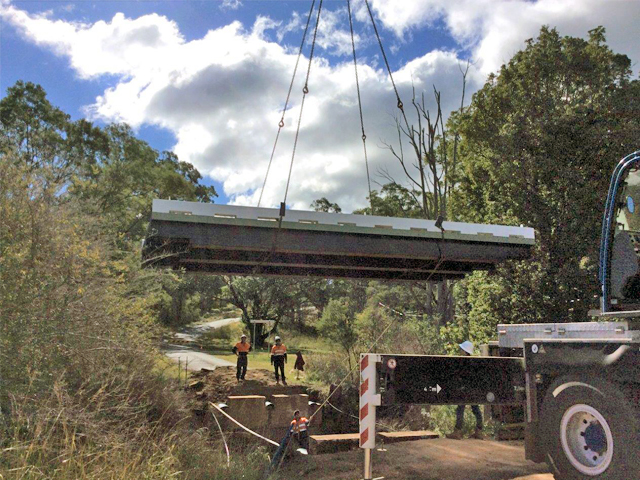BRIDGE SOLUTIONS FROM BIG RIVER GROUP
01 Apr 2021
Big River Group provide solutions that suit every bridge’s need for the construction of motorways and rural roadways.

Woolgoolga to Ballina was the final link in the Pacific Highway to be upgraded to four lanes and is now open to traffic. The Pacific Highway Upgrade project includes advancing the highway to motorway over its 155-kilometre length, nine interchanges, more than 170 bridges and in excess of 350 connectivity structures.
Within the Woolgoolga to Ballina segment, over 102 bridges connect region to region, with the highest and longest crossing in the upgrade spanning 1.5 kilometres. To support this huge upgrade along the coast, leading Australian timber supplier, Big River Group, worked with a number of building companies, supplying around 90 percent of all building materials used on the construction of the many bridges. 
Supplying an array of formwork products, Big River provided solutions that suited all bridge needs from the largest bridge over Clarence River at Harwood, to the bridge over the Richmond River at Broadwater. For the varying headstock sizes, Big River provided a large volume of structural plywood that was placed on top of the headstocks as well as the infills on the Super T Beams.
Big River’s Formwork LVL was used in conjunction with the structural plywood to provide a cost-effective formwork solution. Formply and RedEdge™ were also used for the suspended and ground slab construction. RedEdge™ is light, straight and more uniform than traditional alternatives such as pine and hardwood. To ensure consistency of standard, Big River also supplied a number of formwork accessories that made the building material ordering process much more efficient. 
“This was a great project to be a part of,” says Dave McFeeter, Sales Manager of Big River Group. “Being located in Grafton was a real help to us in terms of being close to the location of the building works. We could easily supply and transport the building materials specified. We made many truckloads to the building site, up to twice a week, making sure we delivered on-time. I was also on-site for much of the project offering technical expertise. The clients were very pleased with our efficiency and expertise which ultimately made their life easier.”
As part of the team who worked on such a large-scale project, Big River Group knows how important the upgrade will be to motorists, however, the bridges the company builds in country Australia are just as important. In regional Australia, bridges maybe one of only a handful of access points connecting regions and the impact on the local community, can be significant. The path of destruction of the 2020 bushfires left over 18.6 million hectares across the country damaged, with many timber bridges that had long connected communities to one another severely affected by fire. 
In New South Wales alone, the bushfires impacted 880km of road network, and after a $64 million project to repair the damage, councils are still working hard to restore local roads and connect communities once more. One of the worst fire-affected areas in Northern New South Wales was the township of Wytaliba, just east of Glen Innes. The remote town was cut off from access during the height of the fires when the main entrance to the town, the Mann River Bridge, was destroyed by the blaze. Local residents reported the concrete structure ‘looked like an earthquake had hit it.’
Following the bushfires, the area was also rocked by floods, with the Australian Defence Force (ADF) needing to set up Flying Foxes across the river to send food to residents until the water levels went down and a bridge could be installed.
It was imperative that access over the river be rebuilt, but without the four to six-month rebuilding time that would come with replacing the six-span concrete bridge. Due to a side track put in by the Glen Innes Council being washed away multiple times, the Council identified the need for a temporary prefabricated bridge of which Big River Group was able to assist. 
Big River Group has developed an engineered timber system that is 100 percent Australian-made in its Grafton factory and consisting of bridge decking, girders, headstocks and corbels along with other engineered sections that can replace existing timbers size for size.
The structural grade engineered plywood bridge deck system acts as an alternative to steel and concrete decks and are less expensive, faster to install, and a critical measure of success for those locations who are lacking council funding and are needing a quick response. In this case, Glen Innis were able to purchase an existing bridge from Big River Group who had one available to be hired for emergency relief.
The process for the Mann River Bridge replacement, installed by Weir Built Engineering and Glen Innes Council, was to redirect and narrow the river, create two new concrete abutments and install the Big River pre-fabricated bridge as a long-term temporary structure until a full bridge replacement was arranged. The ADF built a crane pad to lift all of the bridge components to the middle of the river where it was being installed, resulting in a successful effort from all involved. 
The key feature of Big River’s Engineered Bridge Decking is its capability to be manufactured in continuous lengths to the full width of a bridge, providing excellent load distribution by utilising the full structure, and extensively extending the life of existing structures. The system is an engineered substitute for traditional hardwood decking and is manufactured to AS/NZS 2269-2008 from sustainable Australian plantation pine. When Big River’s Engineered Bridge Decking system is used, it delivers a fully compliant bridge to AS:5100 T44 deflection limits as well as M1600.
Big River Group is offering drop-in services and temporary replacement bridges for immediate solutions to reconnect communities, whilst strengthening and recovering existing timber bridge assets quickly and within council budget.







